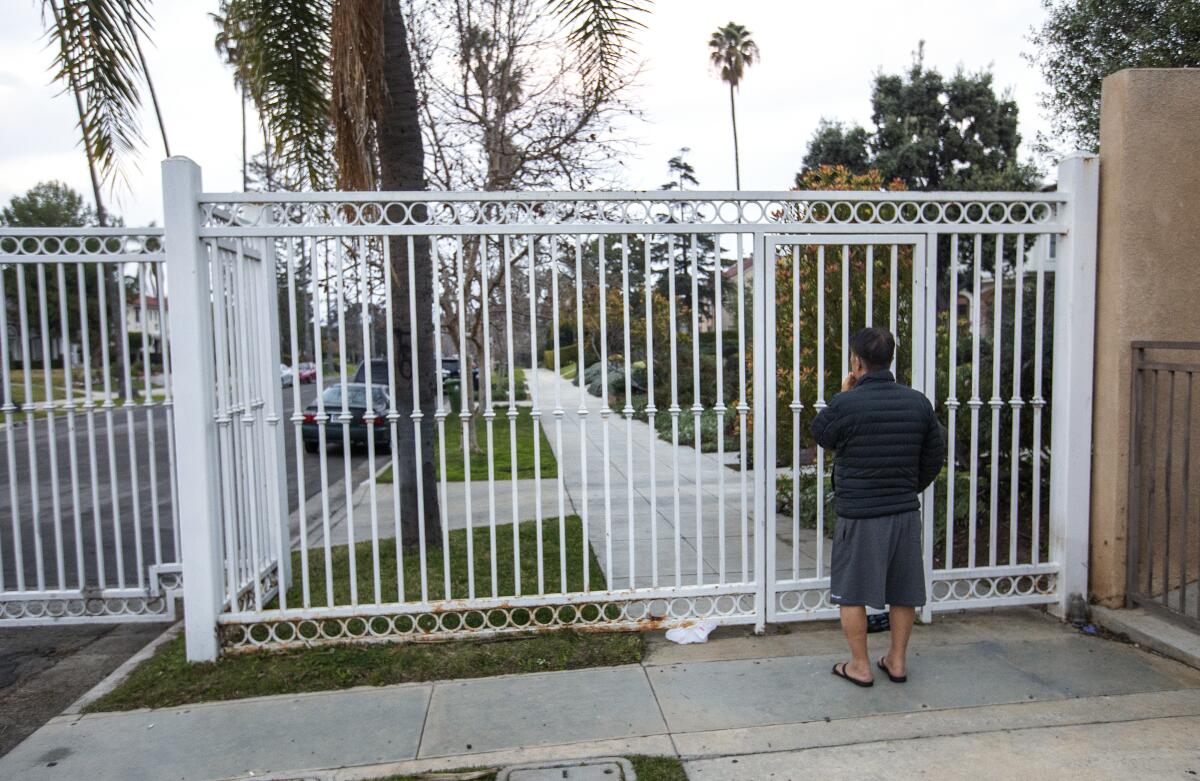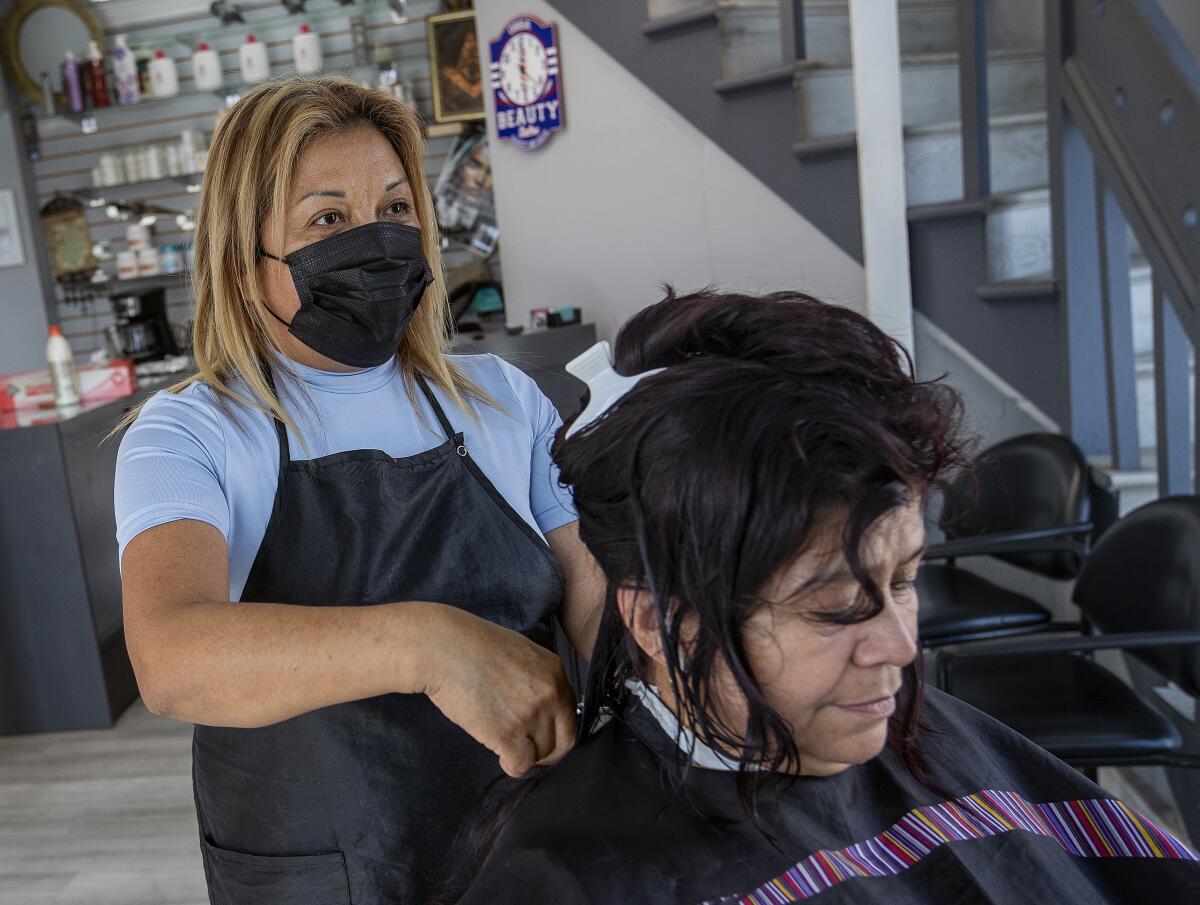Locked gates in historic L.A. neighborhood spark debate in City Council election

Gang crime spurred residents living near Mid-City in the 1980s to erect gates to separate their tree-lined Los Angeles neighborhood from a stretch of Pico Boulevard.
Today, the gates act as a barrier between Pico’s auto shops, beauty salons and low-rise apartment buildings and Country Club Park, a neighborhood to the north that’s known for its Craftsman and Tudor Revival homes and expansive lawns.
Country Club Park residents say the gates create a pleasant, park-like area that draws dog-walkers and strollers from across the city. At Christmas, carolers take to the sidewalks.
Now the gates are an issue in the March 5 election for a Los Angeles City Council seat, sparking a debate about public space and crime.

Some candidates running for District 10, which stretches from Crenshaw to Koreatown, support partly opening the gates so pedestrians can enter from Pico.
Mobility groups also criticize the gates, which remain locked at all hours of the day. A representative for Streets for All, an advocacy group for bus and bike lanes, said blocking access from Pico creates an “undue burden and equity issue on transit riders and pedestrians” living to the south.
Incumbent Heather Hutt is running for a City Council District 10 seat against challengers Aura Vásquez, Eddie Anderson, Grace Yoo and Reggie Jones-Sawyer.
Some Country Club Park residents are apoplectic at the suggestion of removing the gates. About 300 households live on the streets with gates. Break-ins and traffic are common in the neighborhood and crime would be worse if the barriers were gone, some neighbors said.
About 25 residents of the Country Club Park Neighborhood Assn. recently met with a Times reporter, with some saying they’d been labeled “racist” or “gentrifiers” by others on social media for supporting the closed gates.
Some also criticized what they said are the “privileged” pro-bicycling groups calling for the opening of the gates.
“How can you dictate what’s best for us when you do not live here?” said Najmah Brown, an attorney who grew up in the area.

City Councilmember Heather Hutt, who chairs City Hall’s transportation committee, is among five candidates running in the March election and signaled that she would do what the community wants when it comes to the gates.
“If there’s a change, it would be because that’s what they want,” Hutt said.
Another candidate in the race, attorney Grace Yoo, said at a debate last month that she supports “equal access” to the sidewalks.
“I would say yes to opening the pedestrian gates,” Yoo declared.
Community advocate Aura Vasquez, who touts herself as the only candidate in the race who relies on public transit, said at the debate that it’s “unbelievable” that Mid-City residents have to contend with the gates.
“What about the people that have mobility issues?” Vasquez said. “What about if you’re just late to work?”
The gates measure up to 10 feet high at some spots in Country Club Park, a neighborhood that’s also designated as a historical preservation zone because of its architecturally significant homes.
Prominent Black figures, including religious leader Thomas Kilgore, attorney Crispus A. Wright and singer Mahalia Jackson, have lived in Country Club Park, according to the neighborhood association.

The gates date to the mid-1980s, when the Country Club Park Neighborhood Assn. first sought the barriers. Eventually, gates went up along Pico at four intersections: St. Andrews Place, Gramercy Place, Wilton Place and Van Ness Avenue.
In the ‘90s, more neighborhoods across L.A. sought to fully or partly close roads because of rising crime, even as city planners and urban theorists criticized the trend.
“What you’re doing is destroying the democracy of public space,” Mike Davis, author of “City of Quartz,” told The Times in 1992. “If you’re going to allow some communities to block themselves off, why don’t you allow all? Why don’t you just fortify the city, turn the city into living cells connected by freeways?”
Around the same time, the LAPD was touting its success in reducing drug dealing and drive-by shootings by placing concrete barriers on streets in neighborhoods in the San Fernando Valley and elsewhere — a tactic that the department called Operation Cul-de-Sac.

Today, some neighborhoods around Country Club Park also have gated streets. Lafayette Square is blocked along Venice Boulevard, but allows pedestrian access.
Nearby, in West Adams, a gate at Van Buren Place and Adams Boulevard blocks vehicular traffic but also allows pedestrian access.
Country Club Park residents said the gates make them feel more secure. They described people rummaging through their yards or breaking into their homes. Nearby Western Avenue is a known sex trafficking area and prostitutes often park in cars with clients in the neighborhood, locals said.
“We feel unsafe all the time,” said Lydia Lee, whose home was lit on fire last year by an arsonist. “This neighborhood really doesn’t want to open the gates.”
Edmon Rodman moved into a Victorian Revival home on Gramercy Place in Country Club Park in 1999. Shortly afterward, he was asked by the homeowners association, which pays to maintain and insure the gates, to chip in $1,400 for a new gate on Gramercy Place.
Rodman said that the number of cars speeding in the area immediately dropped off. The gates are a “good model for other residential neighborhoods that want to cut down on street accidents,” he said.
Mobility group Streets for All typically supports efforts to create “slow streets” that allow residents to walk and bike in neighborhoods.
But a representative for the group said it doesn’t support the barriers for several reasons, including that the gates block the public right-of-way.
“We understand that residents south of Pico view the gates as a symbol of exclusion from the community,” said Streets for All’s Adriane Hoff. “We support exploring alternative infrastructure which would divert the flow of vehicle traffic which doesn’t have such a harsh meaning to surrounding communities.”
Another mobility group, Open Sidewalks L.A., has launched a petition to open the gates so pedestrians can access Olympic Boulevard and other streets to the north of Pico.
Some residents and businesses on Pico paint the gates as elitist.
“They don’t want us,” said Hector Rebolledo, who lives in and manages an apartment building near the intersection of Pico Boulevard and Van Ness Avenue.

Hilda Figueroa, who works at a beauty shop on Pico, said she understands the concerns about crime, but that it’s “everywhere.”
“They should put gates around their homes if they want to feel safe, not around the street,” Figueroa said in Spanish.
Get the lowdown on L.A. politics
Sign up for our L.A. City Hall newsletter to get weekly insights, scoops and analysis.
You may occasionally receive promotional content from the Los Angeles Times.
One District 10 candidate, Eddie Anderson, a pastor and community organizer, floated the possibility of opening the gates’ pedestrian doors from 8 a.m. to 8 p.m.
Reggie Jones-Sawyer, a state Assembly member who is running for the District 10 seat, said he’s encountered times when he’s tried to go to the restaurant El Cholo on Western Avenue but “realized there are gates there, so I have to backtrack.”
He recently filled out a Streets for All candidate questionaire and stated “we absolutely need to reinstate pedestrian” access around the gates.
However, he told The Times that he’s since talked to Country Club Park neighbors and now believes he needs more information before he can take a side.
More to Read
Sign up for Essential California
The most important California stories and recommendations in your inbox every morning.
You may occasionally receive promotional content from the Los Angeles Times.









